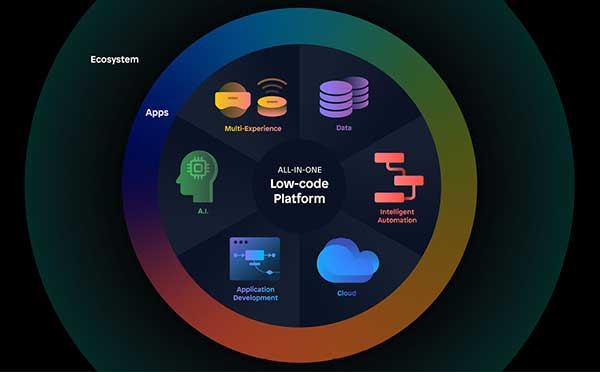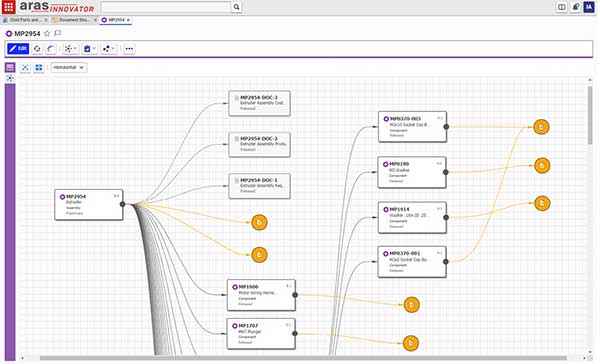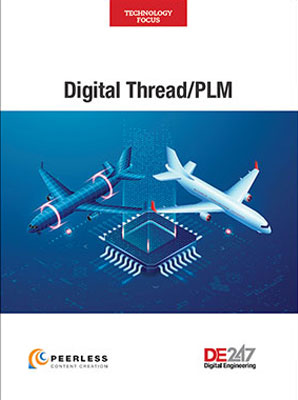Low Code Aims to Democratize Thread Development
The technology shows promise in overcoming many hurdles tied to realizing the full potential of the digital thread.

Fig. 1: LCDP promise to simplify application development by applying programming abstractions via a visual interface, compiling code using drag-and-drop components. Image courtesy of Mendix.
Latest News
March 15, 2021
As digitalization gains momentum, the engineering community, enterprises and manufacturers are up against a brick wall. To move forward, they must come to terms with a new set of market and technology realities.
For organizations that implement digital threads, the obstacles take the form of two seemingly irreconcilable truths: the increasing need for software customization and the absence of the required IT resources that develop the specialized code.
To avoid this impasse, software companies—especially product lifecycle management (PLM) vendors—have reduced their reliance on traditional software development practices and are beginning to increase use of low-code development. Part of the appeal of this technology is that it promises to sweep aside many of the obstacles that hinder digital thread’s full potential (Fig. 1).
Breaking the Bottleneck
To understand how low-code development facilitates digital thread creation through software customization, it helps to examine the forces at play and the constraints with which the technology must contend.
Many companies rely solely on their IT departments to perform application development, customization and integration. This approach is based on the principle that programming is a specialized skill that only a guild-like workforce can perform. This approach, however, creates three problems that hinder companies’ efforts to develop custom applications and achieve optimum digital thread performance.
Taking this tack isolates programmers, separating them from application end users, which often forces programmers to rely on poorly defined requirements and use cases to channel and shape their creations.
To rely on programmers for all software development also stretches IT resources. The reality is that trained and experienced programmers are increasingly in short supply, and the situation will only get worse.
“The explosion of apps has made it impossible for IT teams alone to maintain and build new apps demanded by businesses,” says Daniel Lahl, global vice president of product marketing at SAP.
This means that users are faced with two unacceptable choices: they either have to wait long periods of time before the resources become available for the software to be developed, or they simply have to do without the tools.
The use of a traditional programming approach also means that thread developers with specific business and design expertise, but a lack programming skills, have no way of applying their expertise in the development of the special applications that they require.
This means companies must find a way to offload some of the software development responsibility from their IT departments. To this end, PLM vendors are turning to low-code development. They believe this will create a path to democratization of the application development process, which will in turn mitigate the programming talent shortage, leverage domain knowledge that has been untapped until now, and simplify and shorten development cycles.
One More Hurdle
The development of custom PLM/digital thread applications has been further complicated by the way PLM software providers have viewed customization.
“Historically, PLM vendors designed their software to run out of the box—consisting of many different technology stacks from the same vendor,” says Mark Reisig, vice president of product marketing at Aras.

To support this rule of thumb, PLM vendors contended that companies should adhere to what is known as the “80/20” rule, where customization is limited to 20% of the entire solution.
Unfortunately, this practice hampers digital thread developers’ ability to adapt to changing business, regulatory and technology requirements. In addition, waiting for PLM vendors to provide critical functionality causes PLM deployments to be frozen in time.
What Are LCPDs?
All these obstacles drive home the point that customization is required to get the best fit between a deployable PLM system and specific application needs, and low-code development platforms (LCDPs) support this transition.
Despite the fact that low-code development tools are about a decade old, for many, it represents a new market force, and they are not clear on what the platforms do. Essentially, LCDPs provide GUIs that allow tech savvy users to create custom-designed applications instead of requiring them to use traditional programming tools and methods.
In essence, LCDPs replace coding by enabling the user to compile the code visually with drag-and-drop UI components. These platforms automatically generate all of the application’s components—including frontend and backend code and configuration files—based on standard best practices.
“Because of the visual modeling, or drag-and-drop development options, a maker no longer must be a professional developer who only works in a full-code environment,” says Bill Boswell, vice president of cloud marketing at Siemens Digital Industries Software. “Now, with low-code, business and domain experts—whether they have developer experience or not—can contribute to, or fully build, a functioning application.”
These platforms reduce the amount of time it takes to create software, so that business applications can be delivered more quickly, and a wider range of people (sometimes called citizen developers) can contribute to software development.
When used to build digital threads, LCDPs allow users to access and integrate data from the various repositories and silos, in a range of formats and languages, using RESTful APIs and platform services (Fig. 2).
“This level of software development and integration automation helps tech-savvy business users—those who know their business and processes best—to build their own apps and drive their own experiences with low-code capabilities,” says Lahl. “Business users are enabled to create fit-for-purpose departmental apps with clicks-or-code and without IT intervention, freeing-up IT bandwidth to focus on business-critical processes and tasks.”
Empowering Digital Thread Developers
One of the main ways LCDPs enrich PLM/digital thread projects is that they allow more stakeholders to participate fully in the development process. This not only brings the full weight of the team’s multidiscipline expertise to bear on digital thread development and maintenance, but it also provides them with access to a fuller range of data sources.
“With low-code technology, we can empower PLM users working on various aspects throughout the digital thread to create applications themselves that solve their business problems, regardless of their technology background,” says Boswell. “For example, a PLM business user, who is an expert in their area, may need to gather data from multiple systems. They can now create a low-code app to do this, pulling in data from PLM and other systems.”
The application can also be a way to complete a digital thread with the systems and data sources in place. Because low-code platforms enable integration with a broad range of systems and data formats, the applications can connect to data and simultaneously extend existing systems that are a key part of a digital thread. In doing so, the applications open the door to the critical feedback loop that comes into play when a PLM user can get data from production and performance sources back to designers in real time.
LCDPs also give thread developers access to an expanded toolset and help them to create more efficient relationships between nonprogrammers and the IT department.
“By empowering business experts and design engineers to directly translate their knowledge into executable models, IT can establish a partnership with the business that best leverages the expert skill sets in both domains,” says Lahl. “Design engineers can quickly model digital threads using low-code development tools, while IT can provide the expertise to scale these efforts into larger solutions, such as complex digital twins or complex business processes that span the value chain.”
LCDP Shopping Guide
As exciting as the technology sounds, it is important to remember that not all LCDPs are created equal. So, it is worth noting some features to look for when organizations select a low-code system.
The top considerations are the architecture and automation features. Both of these are important because they determine the platform’s agility. The very nature of digital thread and digital twin require that application development platforms be able to easily meet evolving user demands, changing processes and the addition and deletion of systems with which the platform must interact. All these factors demand modifications to the original software, and this is where LCDPs can help or hinder developers of digital threads.
“Low-code development can play a huge role in adapting to these changes,” says Aras’ Reisig. “An industrial low-code platform that is resilient and agile can begin to meet the challenges of today’s modern business and societal fluctuations.”
Automation features such as the drag-and-drop options in the UIs define the accessibility of the development tools for users just beginning to use the software.
An LCDP must also be flexible enough to support multi-experience applications, ensuring that users can develop software that can be deployed various devices. This will help users to rapidly scale their applications across a range of devices and platforms.
“Because data within a digital thread can come from products as well as the people creating, using, testing and servicing those products, it is important that the app can function in the exact experience the user needs to get or add the data to the thread,” says Boswell. “So, if a service repair person is out in the field using a mobile device, the app should simultaneously work as well on the mobile as it does for the product designer working on a desktop.”
LCDPs must also facilitate software test and validation, particularly when working on digital thread projects. This means providing complete application modeling tools.
“Developers of digital threads should look for LCDPs that allow all tiers of an application to be modeled,” says Lahl. “Many platforms have a ‘closed’ concept of an application, which may be fine for developing conventional apps that have a mobile or web interface. But for developing digital threads, the development platform must support robust modeling of physical concepts in data models and business logic. The platform must be capable of exposing these as micro-services, not just as full-stack apps. This allows these digital threads to be composed into more complex networks or used in solutions with multiple user touchpoints.”
Sill Carving Out Its Niche
If engineers listen to LCDP providers, they may come away with the impression that non-programming professionals from the design and business communities will be the primary beneficiaries of the technology. Take a closer look at market research, and conclude that the market is still deciding LCDPs’ place in the digital thread toolset.
In 2019, a worldwide Forrester survey found that 37% of developers were using or planning to use low-code products. By mid-2020, the research firm predicted that the number would rise to more than half of developers. What is clear is that while IT professionals have begun to take LCDPs for a test drive, they have not totally embraced the technology.
Based on a March 2019 survey of 3,300 IT professionals, OutSystems’ “State of Application Development Report, 2019/2020” reported that 49% of organizations have citizen developers at their company. Of those, 41% use low-code platforms.
As organizations weigh these statistics, and it becomes clear that low-code technology’s role has yet to be defined. The question to be decided isn’t whether the platforms offer value. What has to be decided is who will be the technology’s primary beneficiaries: IT professionals, citizen developers or both.
More Aras Coverage
More Siemens Digital Industries Software Coverage
Subscribe to our FREE magazine, FREE email newsletters or both!
Latest News






